McMurdo SmartFind G8 AIS EPIRB, first of many, PLBs too?
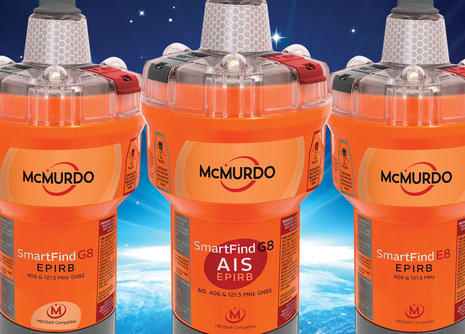 Let's first note that McMurdo's trailblazing SmartFind G8 AIS EPIRB still awaits FCC approval and probably won't be for sale in the U.S. until spring (along with its more conventional E8 and G8 siblings). But McMurdo has definitely developed this useful combination of local and global rescue beacon, other manufacturers may have AIS EPIRBs in the works, and I've got some details about how they'll work. I also have some safety tips from an acquaintance who just dramatically experienced the effectiveness of a current ACR EPIRB...
Let's first note that McMurdo's trailblazing SmartFind G8 AIS EPIRB still awaits FCC approval and probably won't be for sale in the U.S. until spring (along with its more conventional E8 and G8 siblings). But McMurdo has definitely developed this useful combination of local and global rescue beacon, other manufacturers may have AIS EPIRBs in the works, and I've got some details about how they'll work. I also have some safety tips from an acquaintance who just dramatically experienced the effectiveness of a current ACR EPIRB...
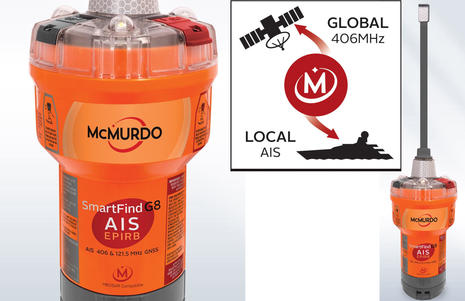 Emergency Position Indicating Radio Beacons (EPIRBs) have earned a tremendous reputation because their 406 Mhz transmissions can be reliably identified and tracked by the international Cospas-Sarsat satellite system, which then reliably passes the boat's distress status to often amazingly capable search and rescue (SAR) services like the U.S. Coast Guard's. Some current EPIRB models include a GPS receiver to speed up beacon location and all also transmit a low-power 121.5 Mhz homing signal, though usually only SAR vessels and aircraft are equipped with 121.5 homing receivers. The advantage of an AIS EPIRB is that it will also transmit an emergency AIS signal to all nearby AIS-equipped vessels, who will then know that you're in trouble and exactly where.
Emergency Position Indicating Radio Beacons (EPIRBs) have earned a tremendous reputation because their 406 Mhz transmissions can be reliably identified and tracked by the international Cospas-Sarsat satellite system, which then reliably passes the boat's distress status to often amazingly capable search and rescue (SAR) services like the U.S. Coast Guard's. Some current EPIRB models include a GPS receiver to speed up beacon location and all also transmit a low-power 121.5 Mhz homing signal, though usually only SAR vessels and aircraft are equipped with 121.5 homing receivers. The advantage of an AIS EPIRB is that it will also transmit an emergency AIS signal to all nearby AIS-equipped vessels, who will then know that you're in trouble and exactly where.
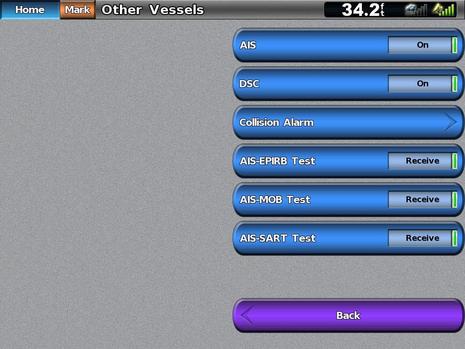 The AIS component of coming AIS EPIRBs like the McMurdo SmartFind G8 is similar to what has already been developed for AIS SARTs and personal MOB beacons. In fact, it was McMurdo and sister brand Kannad who first introduced personal AIS beacons in 2011. Since then Ocean Signal introduced the RescueMe MOB1 personal AIS beacon with added DSC VHF alarming, and ACR just came out with a similarly enhanced AISLink MOB.
The AIS component of coming AIS EPIRBs like the McMurdo SmartFind G8 is similar to what has already been developed for AIS SARTs and personal MOB beacons. In fact, it was McMurdo and sister brand Kannad who first introduced personal AIS beacons in 2011. Since then Ocean Signal introduced the RescueMe MOB1 personal AIS beacon with added DSC VHF alarming, and ACR just came out with a similarly enhanced AISLink MOB.
Perhaps most importantly, most of the display manufacturers eventually created appropriate alarm and homing screens thanks to the unique MMSI number ranges pre-programmed into these various AIS emergency beacons. Hopefully, few boaters have to know that a personal AIS MOB beacon's ID starts with "972" -- or that an AIS EPIRB's will start with "974" -- when Garmin MFDs were already programmed to test the latter back in 2012 (as shown above).
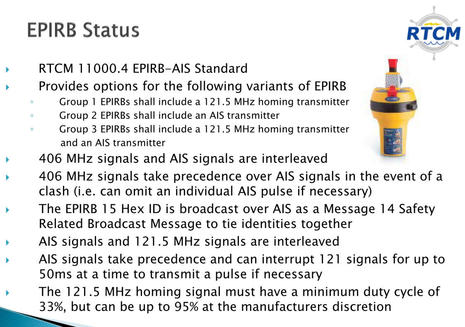 Quietly behind these innovative AIS distress beacons and the improved EPIRB technology is the Radio Technical Commission for Maritime Services (RTCM), and the screen above is clipped from a presentation RTCM made to beacon manufacturers earlier this year (PDF download here). While the RTCM published the 11000.4 EPIRB-AIS standard in 2015, it is not yet official with the FCC and other regulatory authorities. The process typically takes time, and sometimes RTCM standards remain as recommendations instead of regulations, but McMurdo has already received an FCC waiver for its AIS EPIRB (though that's not full type approval) and the details above will most likely be seen in the SmartFind G8.
Quietly behind these innovative AIS distress beacons and the improved EPIRB technology is the Radio Technical Commission for Maritime Services (RTCM), and the screen above is clipped from a presentation RTCM made to beacon manufacturers earlier this year (PDF download here). While the RTCM published the 11000.4 EPIRB-AIS standard in 2015, it is not yet official with the FCC and other regulatory authorities. The process typically takes time, and sometimes RTCM standards remain as recommendations instead of regulations, but McMurdo has already received an FCC waiver for its AIS EPIRB (though that's not full type approval) and the details above will most likely be seen in the SmartFind G8.
Most interesting, I think, is how an AIS EPIRB's unique hex code will be broadcast over AIS using the Safety-Related Broadcast Message. EPIRBs do not use MMSI boat registration numbers -- heck, the RTCM published the first EPIRB standard in 1987 -- but this technique will tie an EPIRB owner's registration information to the AIS emergency signal without any extra effort on the owner's part. Smart!
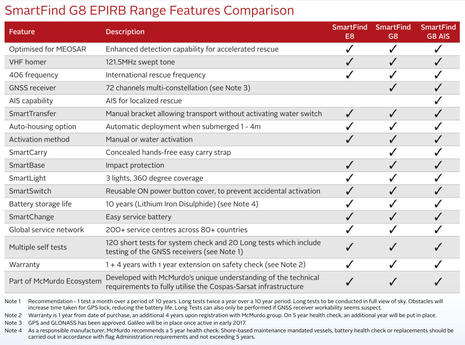 EPIRBs are improving in other ways besides AIS, as this table comparing the new McMurdo E8/G8 line indicates. Note, for instance, that the 72-channel GNSS receivers included in the two G8 models will use both the GPS and GLONASS satellite constellations and also Galileo when it (finally) goes online "in early 2017." Fast and accurate position finding from a completely cold start while floating in the ocean is a challenge, and this will help. But these EPIRBs are also "optimised" for the coming MEOSAR improvement to the Cospas-Sarsat system, which should speed up tracking regardless of internal GNSS receivers. Redundancy! (Note that while McMurdo is involved with MEOSAR infrastructure and a big proponent, it will be backward compatible with all existing EPIRBs and PLBs at least to some degree.)
EPIRBs are improving in other ways besides AIS, as this table comparing the new McMurdo E8/G8 line indicates. Note, for instance, that the 72-channel GNSS receivers included in the two G8 models will use both the GPS and GLONASS satellite constellations and also Galileo when it (finally) goes online "in early 2017." Fast and accurate position finding from a completely cold start while floating in the ocean is a challenge, and this will help. But these EPIRBs are also "optimised" for the coming MEOSAR improvement to the Cospas-Sarsat system, which should speed up tracking regardless of internal GNSS receivers. Redundancy! (Note that while McMurdo is involved with MEOSAR infrastructure and a big proponent, it will be backward compatible with all existing EPIRBs and PLBs at least to some degree.)
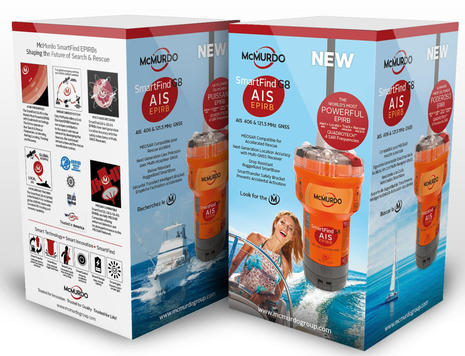 So far, McMurdo has only announced the SmartFind G8 AIS EPIRB (and its Kannad SafePro equivalent) to the commercial shipping world, but this packaging certainly suggests that they also have recreational boats in mind. No pricing is available due to the FCC wait, but this will be a premium EPIRB with three different transmitters and a receiver all usefully built in.
So far, McMurdo has only announced the SmartFind G8 AIS EPIRB (and its Kannad SafePro equivalent) to the commercial shipping world, but this packaging certainly suggests that they also have recreational boats in mind. No pricing is available due to the FCC wait, but this will be a premium EPIRB with three different transmitters and a receiver all usefully built in.
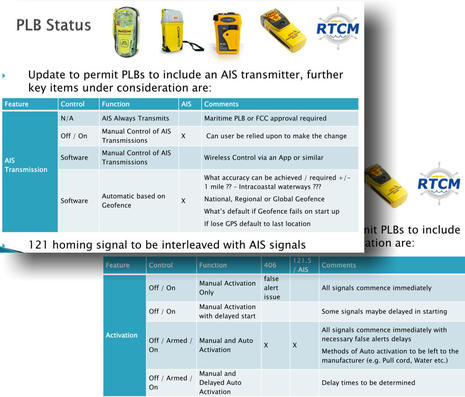 And guess what? An AIS Personal Locator Beacon (PLB) standard is at least being discussed. The slides above are from the same RTCM presentation at the 2016 Beacon Manufacturers Workshop, and while they suggest that several issues have yet to be worked out before manufacturers can even attempt to build one, wouldn't it be great to have a global/local distress beacon you could put in a small boat or carry around on the deck of a big one?
And guess what? An AIS Personal Locator Beacon (PLB) standard is at least being discussed. The slides above are from the same RTCM presentation at the 2016 Beacon Manufacturers Workshop, and while they suggest that several issues have yet to be worked out before manufacturers can even attempt to build one, wouldn't it be great to have a global/local distress beacon you could put in a small boat or carry around on the deck of a big one?
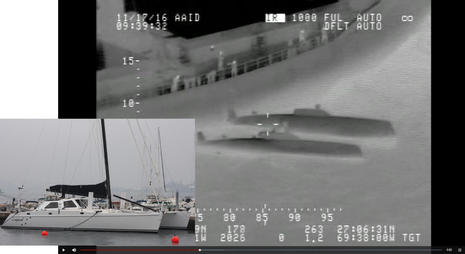 Now let's switch gears from emergency beacon technology to what it's like to actually use one. Picture yourself as the professional skipper/manager of a beautifully-built 2008 Atlantic 57 sailing cat well along on a recent delivery from the Chesapeake to St. Martin. You're in t-shirt-and-shorts-at-night weather now, though blustery, and during your evening watch you've depowered the sail plan a bit more so that a mate can finish making dinner.
Now let's switch gears from emergency beacon technology to what it's like to actually use one. Picture yourself as the professional skipper/manager of a beautifully-built 2008 Atlantic 57 sailing cat well along on a recent delivery from the Chesapeake to St. Martin. You're in t-shirt-and-shorts-at-night weather now, though blustery, and during your evening watch you've depowered the sail plan a bit more so that a mate can finish making dinner.
But suddenly roaring out of the dark comes what was likely a tornadic waterspout that lifts and flips the whole catamaran so quickly you don't even have time to reach the autopilot standby control, leaving the three of you to deal with an instantly upside-down world of water-filled main cabin, escape hatches, ditch bags and worry. Finally put yourself on the cat's slippery bottom in the USCG thermal video (though of course its very existence is very good news).
If it weren't for good preparation and what sounds like a sterling level of calm in duress, I'm not sure that the crew of Leopard would have enjoyed the results of their EPIRB and the responding USCG aircraft that worked the rescue with a fairly nearby freighter. And I might never again have heard the cheery voice of the skipper Charles Nethersole (who enjoys summers in Camden between boating jobs).
It occurred to me to connect Charles with my sailing writer buddy, Charlie Doane, and the excellent result was first a detailed WaveTrain report on the capsize/rescue, and then a followup dealing with the inevitable peanut gallery criticism that follows such incidents these days. I've also spoken with Charles, still cheery, and of course he has some ideas about how to prepare even better for what he hopes to never endure again.
In fact, Nethersole has some specific ideas along the lines of improved escape hatches and non-skid bottom paint pathways that will hopefully get the interest of catamaran builders and owners. But I focused on the general details of using the EPIRB, which was an ACR GlobalFix Pro that Charles purchased 3 years ago (on behalf of Leopard's owner) along with a RapidDitch Express Bag like the one above.
Before the voyage, the bag had been loaded with the EPIRB, a fully-charged handheld VHF, an Electronic SOS Signal and other gear, and then secured near one of the cat's escape hatches along with survival suits and even a small scuba rig. The life raft was secured in the main cabin because it wouldn't fit through an escape hatch (and the scuba wasn't needed because the other mate managed to retrieve it unassisted).
But the VHF fell out of the ditch bag's side pocket on the way out to the capsized boat's bottom -- not to be seen again, though it would have been very handy when the freighter arrived -- and apparently that whole process was somewhat chaotic. The next time Charles would not only secure the contents of the bag better but use something like surfboard leashes to assure control of the bag and the other critical items.
Apparently, there was also some confusion about whether the EPIRB was working right -- it has both manual and water activation, but the green GPS LED may have gone out briefly when they were holding the device inside a wetsuit -- and I'm sure that Charles will study the workings of the next one better lest he again loses his glasses during the incident.
It happens that I've been testing the same ACR ditch bag for a while on Gizmo, but after talking to Charles thought I'd actually see how it floats with about 10 pounds of assorted hardware inside. Hence the impressive high freeboard photo above. But I was surprised to see that a few Amazon RapidDitch Express reviewers were disappointed that the bag is not completely watertight, even though ACR doesn't claim so and specifies its buoyancy at "15 lbs dead weight with bag flooded..." Isn't a ditch bag mainly meant to keep stuff organized and with you in the water where its interior is probably going to get wet anyway?
And shouldn't we all think about such details before they're suddenly upon us in the dark of night? I spent some time conjuring up ditch bag layouts, as suggested below, and Amazon reviewers please note that quite a few 8x5x3 inch waterproof containers like the one shown would fit in that commodious main compartment. I was also pleased that the ACR Aqualink View PLB I started testing in 2010 still self-tests fine, and told me so on its little screen.
And do check out the droll Nethersole-inspired ditch bag label I made in case I ever really test this bag. On future voyages -- he's offshore again now actually -- Charles plans to have the crew's identification documents as ready for an ugly surprise as the EPIRB and handheld VHF. In fact he's looking for easy-to-hang-around-your-neck personal waterproof ID containers, adding something like, "Hell, that would be useful whether you end up dead or alive!"
I'm really glad that Charles is still with us, and I remain in awe of what the rescue systems and personnel can do to help us out there. Which reminds me of one reason that Charlie Doane covers ocean accidents so well and why we should support the Coast Guard Foundation.

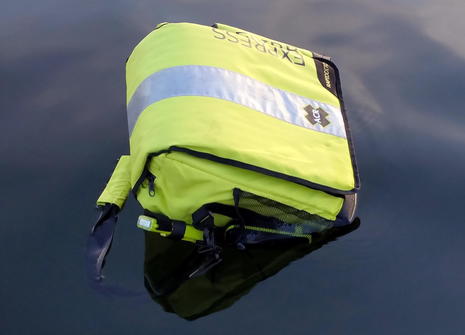
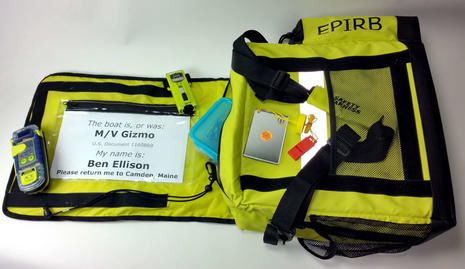
 Share
Share
I was thinking long and hard about Charlie's article while passing through torrential squalls and dodging waterspouts on our way from St. Augustine to Nassau. The advice you pass along is timely and I will repack our ditch bag (same as yours) so items don't wash away so easily.
Referring to your most recent article on solid state radars and the comments about their lack of power to see in heavy rain: Our Furuno 1835 with a 4 kW dome doesn't really have sufficient power to see targets in torrential squalls. It would have nice since quite a few large private yachts were racing through paradise at 20+ kn without AIS. I was praying they knew how to tune their high power radar for torrential rains.
Cheers Ben and Happy Holidays
Don